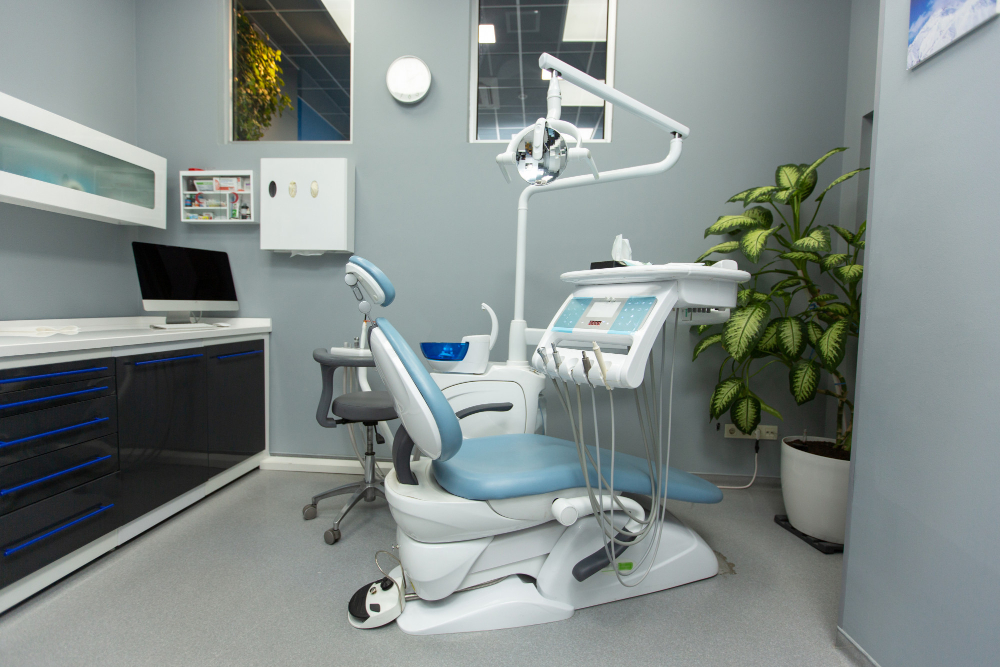
Interior & Exterior Design
Clinics Design
Essential Tips for Designing a Patient-Centered Clinic
A clinic’s design must balance clinical efficiency with a calming, welcoming atmosphere. It directly impacts patient anxiety, staff workflow, and the overall perception of care.
1. Prioritize a Clear and Logical Floor Plan (Patient Flow)
The layout is the most critical element for efficiency and reducing stress.
Zoning: Create distinct zones:
Public Zone: Reception, waiting area, restrooms.
Clinical Zone: Examination rooms, procedure rooms, nurse stations.
Staff Zone: Offices, break rooms, staff restrooms.
Separation of Paths: Ideally, design separate circulation paths for patients, staff, and (if applicable) medical supplies/linen. This minimizes cross-traffic, enhances privacy, and improves efficiency.
Intuitive Wayfinding: Use clear signage, color-coding, or subtle changes in flooring to guide patients effortlessly from the entrance to reception, to the waiting area, and to their examination room.
2. Create a Calming and Welcoming Atmosphere
A clinic should actively reduce patient anxiety.
Soothing Color Palette: Use soft, neutral colors (e.g., soft blues, greens, lavenders, warm grays, beige). Avoid stark white and overly bright, stimulating colors.
Abundant Natural Light: Maximize natural light in waiting and reception areas. It boosts mood and reduces the perception of wait times. In examination rooms, ensure windows have controllable shading for privacy.
Comfortable Acoustics: Noise increases stress. Use sound-absorbing materials like acoustic ceiling tiles, carpeting, fabric wall panels, and soft furnishings to dampen sound. Consider a sound masking system.
Thoughtful Artwork: Choose calming, nature-inspired, or abstract art. Avoid controversial or complex imagery.
3. Design an Efficient and Discreet Reception Area
This is the first point of contact and sets the tone.
Clear Line of Sight: Patients should see the reception desk immediately upon entering.
Privacy: Design the reception counter to provide visual and auditory privacy for patients checking in or discussing billing. A slightly raised counter with partitioned sections or glass screens can help.
Comfortable Waiting Area:
Arrange seating in small groupings rather than long, impersonal rows to offer choice and a slight sense of privacy.
Provide a variety of seating (chairs with arms, without arms) to accommodate different needs.
Include dedicated space for children if applicable.
4. Optimize Examination and Consultation Rooms
These rooms are the core of the clinical experience.
Standardization: Design all examination rooms to be identical in layout and where supplies are stored. This drastically improves staff efficiency and reduces errors.
The “Within Reach” Principle: Design the room so that the physician can access the sink, examination tools, computer, and hand sanitizer without taking more than a step or two.
Incorporate Patient-Centered Technology: Mount flat-screen monitors on a wall arm so they can be shared between the doctor and patient for reviewing results or educational content.
Dedicate Space for the Patient: Ensure there is a clear, comfortable place for the patient’s personal belongings (a hook for a coat, a small shelf for a purse). The room should feel designed for them, not just for the equipment.
5. Ensure Strict Hygiene and Easy Maintenance
Infection control is non-negotiable.
Non-Porous, Cleanable Surfaces: Choose materials for floors, walls, and countertops that are seamless, non-absorbent, and easy to clean and disinfect (e.g., vinyl flooring, solid surface countertops, epoxy paint).
Hand Hygiene Stations: Place hand sanitizer dispensers at every key point: entrances, exits, outside every examination room, and inside every room.
Durable Furniture: Select furniture that can withstand frequent cleaning with harsh chemicals.
6. Incorporate Technology Seamlessly
Technology should support, not hinder, the workflow.
Robust IT Infrastructure: Ensure strong Wi-Fi coverage and ample power outlets, including integrated outlets in waiting area seating and examination rooms.
Electronic Health Records (EHR): The design should support the use of EHRs, with comfortable computer stations for clinicians that do not create a physical barrier between them and the patient.
Patient Portals: Provide a kiosk or tablets in the waiting area for patients to update their information or access educational materials.
7. Adhere to Accessibility and Safety Standards
The clinic must be safe and accessible for everyone.
Universal Design: Follow ADA (Americans with Disabilities Act) or your local equivalent guidelines meticulously. This includes wide doorways, grab bars in restrooms, accessible examination chairs, and clear floor space for wheelchair maneuvering.
Safety and Security: Ensure good sightlines for staff to monitor waiting and corridor areas. Have a secure area for storing medications and confidential records. Use slip-resistant flooring, especially in high-moisture areas.
8. Support Staff Well-being and Workflow
A well-designed clinic supports its staff, reducing burnout and improving care.
Efficient Nurse Stations: Design centralized or decentralized stations that minimize the distance staff need to travel. Ensure they have everything they need within reach.
Dedicated Staff Areas: Provide a comfortable, well-lit break room completely separate from patient areas where staff can truly relax and recharge. This is essential for mental well-being.
Ample Storage: Provide sufficient and well-organized storage for medical supplies, linens, and equipment to keep workspaces clutter-free.
Common Clinic Design Mistakes to Avoid
Poor Workflow: Creating a layout that forces staff to walk excessive distances or causes patient and staff paths to constantly cross.
Neglecting Patient Privacy: Thin walls, poor soundproofing, or check-in desks where conversations can be easily overheard.
An Institutional Feel: Using cold, harsh lighting and sterile, unwelcoming materials that increase anxiety rather than alleviate it.
Insufficient Space in Exam Rooms: Not leaving enough room for a patient, a family member, a wheelchair, and the clinician to move comfortably.
Ignoring Future Flexibility: Not designing with adaptability in mind for new technology or changing medical practices.
In summary, a successful clinic design thoughtfully merges the clinical needs of the staff with the emotional and physical needs of the patient, creating a space that is both highly functional and deeply human-centered.






